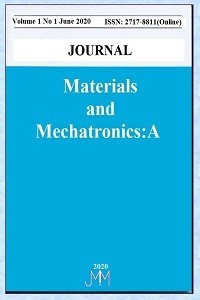Plazma Püskürtme ile Üretilmiş Beyaz ve Gri Al2O3 Kaplamaların Mekanik Özellikleri
AISI 304 L, Plazma püskürtme, Gri alümina, Beyaz alümina
Mechanical Properties of White and Grey Al2O3 Coatings Fabricated by Plasma Spray
AISI 304 L, Plasma spraying, Gray alumina, White alumina,
___
- Chráska P., Dubsky J., Neufuss K., Písacka, J., Alümina-base plasma-sprayed materials part I: Phase stability of Alümina and Alümina-chromia. Journal of Thermal Spray Technology, 6(3), 320-326, 1997.
- Gill B.J., Tucker R.C., Plasma spray coating processes. Materials Science and Technology, 2(3), 207-213, 1986.
- Liu R., Li D.Y., Modification of Archard’s equation by taking account of elastic/pseudoelastic properties of materials. Wear, 251(1-12), 956-964, 2001.
- Sarikaya O., Effect of some parameters on microstructure and hardness of Alumina coatings prepared by the air plasma spraying process. Surface and Coatings Technology, 190, 388-393, 2005(a).
- Sarikaya O., Effect of the substrate temperature on properties of plasma sprayed Al2O3 coatings. Materials & Design, 26, 53-57, 2005(b).
- Smith D.L., Thin-film deposition: principles and practice. New York: McGraw-Hill; 1995.
- Taktak S., Some mechanical properties of borided AISI H13 and 304 steels. Materials & Design, 28, 1836-1843, 2007.
- Toma F.L., Stahr C., Berger L.M., Saaro S., Herrmann M., Deska D., Michael G., Corrosion resistance of APS and HVOF sprayed coatings in the Al2O3-TiO2 system. Fraunhofer IWS, 19, 2010.
- Gao Y., Xu X., Yan Z., Xin A., High hardness Alümina coatings prepared by low power plasma spraying. Suarface &Coatings Technology, 154, 189-193, 2002.
- Yayın Aralığı: Yılda 2 Sayı
- Başlangıç: 2020
- Yayıncı: Yusuf KAYALI
ROS/Gazebo Ortamında Tank Sürüş Özellikli Mobil Bir Robotun Simülasyonu
Yavuz Bahadır KOCA, Barış GÖKÇE, Yılmaz ASLAN
Plazma Püskürtme ile Üretilmiş Beyaz ve Gri Al2O3 Kaplamaların Mekanik Özellikleri
Muhammed KARABAŞ, Ersan MERTGENÇ
Mobil Cihazlar için Uygulama Geliştirmekte Kullanılan Platformların ve Dillerin Karşılaştırılması
Sait Mahmut ÇINAR, Hilmi BİLİCİ
Borlanmış AISI 316 L Paslanmaz Çeliğin Difüzyon Kinetiğinin İncelenmesi
